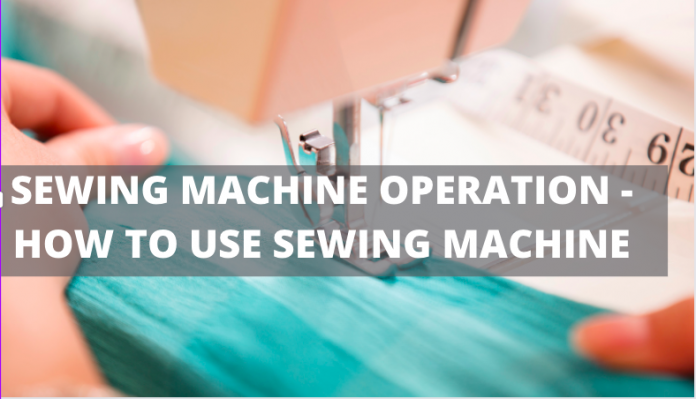SEWING MACHINE OPERATION – HOW TO USE SEWING MACHINE
Sewing machines use a combination of wheels, standard engineering components, and other mechanisms to operate. These components, which include gears, cams, and cranks, are all descended from wheels.
Electricity and electronics are now used to power and control modern machines. Though it seems that sewing machines appeared overnight, their evolution was slow.
They evolved over the centuries, from a simple device to a fully automated machine for joining materials.
How to Use a Sewing Machine
Before you begin using your sewing machine, you’ll want to learn a few things. For example, you should keep the user’s manual handy. The manual for your machine may vary slightly from another model’s, so make sure to consult it before you start using your machine.
In addition, you should learn about the presser foot, which is the metal part of the machine that lowers and raises when sewing.
When starting, you’ll probably need to set up your machine. Sewing machines usually have a diagram that shows how to thread them, so it’s best to follow this if possible.
If you don’t have the owner’s manual, look online for instructions or ask a more experienced person to show you how to use your machine. After you’ve got the basic machine setup, you can start creating your first project!
How to load thread into a sewing machine
Before you can start sewing, you need to load your sewing machine with thread. To do this, you must first place the spool of thread on the spool pin.
The spool pin may be vertical or horizontal, depending on your machine. To insert thread, push the spool pin in the right direction, with the flat side facing the machine’s front. Then, pull the thread up and over the thread guide, and then around the tension discs.
When threading your sewing machine, you must always turn the sewing machine off. You should use the bobbin thread and the top thread, if any.
When threading the bobbin, you should use your left hand to pull the thread through the needle plate. It is recommended to practice threading your sewing machine several times before using it.
After you’ve mastered this process, you’ll be able to thread it quickly and correctly when the bobbin runs out.
Threading your sewing machine requires following instructions in your manual. You will need to turn the machine off before threading the needle.
Some sewing machines come with a built-in needle threader, which makes this task a snap! When threading your bobbin, make sure the thread is a tight enough spool. Then, move the foot pedal to the left and the bobbin will begin to wind.
How to sew clothes with hand
You can start to sew by hand if you don’t feel comfortable using the sewing machine. To sew by hand, you will need a sewing needle, a security stitch, and thread.
The security stitch is used to secure the thread end. This way, it can’t unravel. Start small and make simple projects first before moving on to more complicated items. Here are some tips to help you get started.
First, press your fabric before you start sewing. Then, thread the needle by knotting the end of the thread. When sewing from the left side, send the needle through the underside of the hem, and then through the top portion of the fabric.
Once you’ve completed sewing the top section, pull the thread up and to the right one eighth inch. Repeat this process on the other side. Your sewing machine will take care of the rest, but it’s still easier to do the same steps by hand.
Difference between hand and machine sewing
If you’re a beginning sewist, you may wonder what the difference is between hand and machine sewing. While hand sewing is a good option for small projects, machine sewing is far more convenient.
If you’ve only sewn a few items or just want to practice hand sewing, you might benefit from learning how to use a sewing machine. Listed below are the pros and cons of each. Which one is better?
Firstly, hand sewing takes longer and isn’t as professional-looking. Secondly, machine sewing allows you to do zigzag stitches to finish seams and give your work a more professional finish.
Hand sewing also doesn’t have a consistent seam allowance, which is essential to make sure patchwork squares line up properly. With a sewing machine, you can calculate the proper seam allowance for each stitch.
We appreciate you taking the time to read!
Finally, we hope you found this article interesting? And what do you think about ”SEWING MACHINE OPERATION – HOW TO USE SEWING MACHINE”
Please feel free to share your thoughts with us in the box below.
Check the facts
With accuracy and impartiality, we endeavour to deliver the most up-to-date essential information for fashion enthusiasts.
Please contact us if you would like to contribute to this article or advertise with us.
And let us know if you notice something that isn’t quite right.













